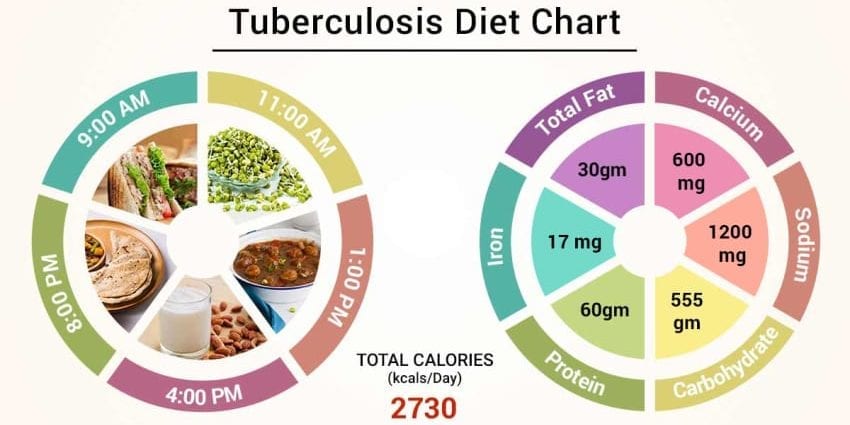General description of the disease
Pulmonary tuberculosis is an infectious disease caused by the tubercle bacillus (also known as Koch’s bacillus), an aggressive and resistant microbe. This disease is characterized by the formation of foci of specific inflammation in the affected tissues, as well as a pronounced general reaction of the body. Koch’s wand is able to survive for a long time in the soil, on the surface of contaminated objects, dried phlegm and is resistant to many disinfectants.
The main mode of transmission of pulmonary tuberculosis is aerogenic, i.e. the bacterium enters the body with the inhaled air. In addition to the aerogenic method of infection, infection is also possible through food or through contact with objects infected with Koch’s bacillus. Under certain conditions, human disease can be caused by microbacteria found in the body of cattle.
Symptoms
Quite often, pulmonary tuberculosis occurs without visible symptoms and can be detected by chance, for example, during fluorography. One of the first symptoms of the disease are: weakness, weight loss, worsening sleep, increased sweating, decreased appetite, dizziness, fever (about 37 degrees), an increase in lymph node groups. If at this stage of the disease you do not seek medical help, then over time, the above symptoms will be added: cough with sputum, shortness of breath, chest pain, bleeding when coughing. The last two symptoms are a sign of a complex form of the disease and require immediate treatment.
Useful foods for pulmonary tuberculosis
Features of nutrition for pulmonary tuberculosis
Proper nutrition for this disease can not only bring the patient’s weight back to normal, but also significantly reduce the intoxication of the body, as well as increase the resistance of the disease. Based on this, it can be concluded that proper nutrition is an important element in anti-tuberculosis treatment.
First of all, the patient’s diet should contain an increased amount of calories, but you should not overfeed the patient. Only when the patient is exhausted should a diet with an increased (by 20-25% of the daily value) calorie content be prescribed. In other cases, preference should be given to a balanced diet rich in vitamins A, B and C. A long-term diet with an excess of calories can lead to obesity.
Healthy foods
- High protein foods… In the patient’s body, proteins break down faster than in a healthy person, so it is necessary to include a high protein content in the diet. These are: dairy products, eggs, fish, poultry, veal.
- Fatty foods… The fat content in the patient’s diet should be slightly more than the norm, but do not forget that excess fat in the diet can lead to indigestion and liver disease. A sufficient amount of fat is found in olive oil, fish oil, butter. It is not recommended to eat pork, beef and lamb fat.
- Foods rich in carbohydrates… Carbohydrates are found in cereals, various flour products, sugar. It is recommended to include in the diet buckwheat, rice, semolina, wheat bread, honey, jam.
- Vegetables, fruits, berries… During illness, the patient’s body needs vitamin C in large quantities. Vitamin C is found in lemons, kiwi, oranges, and strawberries. Vegetables are rich in vitamin C: cabbage, onions, bell peppers, etc. Vegetables can be eaten both fresh and in the form of stews, mashed potatoes, soups, etc. Vegetables do not have any contraindications.
Approximate diet for the day:
- Breakfast: fried fish with mashed potatoes, various vegetables, butter (about 20 grams), tea.
- Dinner: borscht with sour cream, baked meat with peas or porridge, vegetables, juice from vegetables or fruits.
- Dinner: cottage cheese with sour cream, fruit puree or jam, butter (about 20 grams), coffee with milk or tea.
- Before bedtime: a glass of kefir.
Folk remedies for the treatment of pulmonary tuberculosis
Useful products of beekeeping, in case of lung tuberculosis, are not only honey, but also propolis, bee bread, drone milk, honeycomb, bee pollen, tincture of wax moth. Beekeeping products are strong immunostimulants that increase the body’s defenses.
- Wax moth larva extract… It has an anti-inflammatory effect.
- Propoliswhich is a natural antibiotic. It should be consumed in two ways: in the form of an alcoholic tincture or glue a small pinch to the gum for three days. The tincture (20-40 drops) is added to milk or water and taken three or four times a day, one and a half hours before meals. Propolis prevents inflammation and removes toxins from the body.
- Perga contains a lot of potassium, thanks to which the work of the heart improves, the metabolism is normalized. Perga is taken three times a day at 3 grams.
Also, with pulmonary tuberculosis, it is worth taking various herbal decoctions or tinctures. They help fight coughs and hemoptysis.
Dangerous and harmful foods for pulmonary tuberculosis
A diet with exhaustion and pulmonary tuberculosis allows you to eat any food, however, very fatty varieties of fish and poultry, lamb, beef and cooking fats should be removed from the diet. In addition, you should refuse hot and fatty sauces, cakes and pastries with a lot of cream.
Attention!
The administration is not responsible for any attempt to use the information provided, and does not guarantee that it will not harm you personally. The materials cannot be used to prescribe treatment and make a diagnosis. Always consult your specialist doctor!











buna vederea nestabilă dela Tuberculoza în cît tip se stabilește seuită încrucișatî iafost afectata și vederea